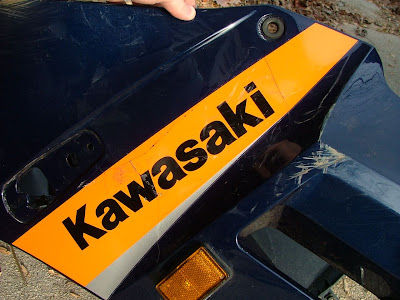As you might have guessed, I wanted to take the time to review a bike Matt mentioned in the post about the standard motorcycle category, the Buell Blast.
What can be said about the smallest motorcycle manufactured by an American company? First and foremost, it is definitely not
just a beginner's bike. While it fills the role of a great motorcycle to learn on, due partially to it's relatively low weight and low powered engine, it can also be used for a variety of other things. But, more of that later.
First things first, a few details about the machine. With a MSRP of $4,795 it costs more than the smaller bikes such as the Nighthawk, or Ninja 250, but still is less than a new GS500F will set you back. Accordingly, it's horse power rating is also in the middle of the pack, generating 34 HP at 6500 rpm. Since it has a dry weight of 360 pounds, that still gives it one horse power per ten pounds. A respectable power to weight ratio for something never designed to win races.
What it is designed to do is help you learn to be a better, more capable motorcyclist. Here it shines. The clutch pull has been light and even on the Blasts I have ridden and the friction zone wide and easy to find, unlike other bikes such as most Yamahas and even my Ninja. The one thing that does put off some people about the Buell is it's engine. It has a single cylinder. This leads to a fair amount of vibration, especially at low rpms. Although, once the engine is revved higher it smooths out considerably.
As discussed in the previous post, it has the classic ergonomics of a standard. With a seat height of 27.5 inches (25.5, if you have the low-profile seat option from the factory) it is relatively easy for most riders to flat foot. The handlebars are set just above hip height and an easy reach while sitting upright. Finally, the foot pegs are located almost directly beneath the knee. All together, it has a relaxed riding position meant to inspire confidence in the rider.
Now, to the meat of the matter and what everyone wants to hear about. Performance and handling. True to form from Buell, it has more torque than a bike of its size and class has a right to expect. It will pull away from a stop light and any traffic without any problem and the five-speed gearbox will get you comfortably up to highway speeds (and enough beyond for you loose your license before the governor kicks in.) The Blast might not be the fastest kid on the block, but it definitely won't hold you back. As I said earlier, the single cylinder thump smooths out well at higher rpms and near the HP sweet spot.
That engine is all well and good for going in a straight line, but what about when you have to turn? This is where Buell prides themselves and the smallest member of their line up is no exception. With the signature under slung exhaust it has a very low center of gravity and with a rake of only 25 degrees it turns in well without being twitchy. Combine that with a suspension travel of over 4 inches front and back, you get a bike that stays planted in the turns without fighting you to fall in or stay upright.
Here is the Blast that resides in our garage.

As you can see it has an aftermarket windscreen on it, making it much more friendly for long distances or highway speeds for any length of time. What you don't see are the saddlebags that we had removed on the day this picture was taken. With just a little bit of effort, the Blast makes for a decent, albeit small, touring motorcycle. The small (2.8 gallon) fuel tank also hampers it a bit in that category. Although, it does actually achieve the factory claims of 65-70 miles per gallon, and we have even seen it reach 90 mpg on a day of back country highway riding.
All told, its a wonderful little bike to learn on and even keep as a daily commuter, if that's what you're looking for. But, the lack of easy storage and small tank will hold it back from being a true all around motorcycle.










